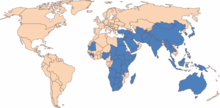| Bovine fever ephemerovirus | |
|---|---|
| Virus classification | |
| (unranked): | Virus |
| Realm: | Riboviria |
| Kingdom: | Orthornavirae |
| Phylum: | Negarnaviricota |
| Class: | Monjiviricetes |
| Order: | Mononegavirales |
| Family: | Rhabdoviridae |
| Genus: | Ephemerovirus |
| Species: | Bovine fever ephemerovirus |
| Synonyms | |
|
Bovine fever virus | |
Bovine ephemeral fever (BEF) also known as Three Day Sickness is an arthropod vector-borne disease of cattle and is caused by bovine ephemeral fever virus (BEFV), a member of the genus Ephemerovirus in the family Rhabdoviridae.
Virology

BEFV forms a bullet- or cone-shaped virions that consist of a negative, single stranded RNA genome with a lipid envelope and 5 structural proteins. The envelope glycoprotein G contains type-specific and neutralizing antigenic sites. There has been recent evidence which demonstrated that BEFV induces apoptosis in several cell lines. It was however shown that apoptosis could be blocked by the caspase inhibitor (Z-VAD-fmk), indicating that BEFV induces caspase-dependent apoptosis in cultured cells.
Location

The virus has been found in tropical and subtropical regions of Asia, Africa and through eastern Australia. It is not found in the Americas, or in Europe (except western parts of Turkey).
Transmission
The virus is transmitted by an insect vector. The particular species linked to the virus are the biting midges Culicoides oxystoma and C. nipponensis.
Disease characteristics

The characteristics of the disease are the sudden onset of fever, stiffness, lameness and nasal and ocular discharges. BEF often causes hypocalcaemia which in turn generates clinical signs such as depression, cessation of rumination, muscle tremors and constipation.
Although the pathogenesis of the disease is complex it seems clear that the host inflammatory responses, mediated by the release of cytokines, are involved in the expression of the disease.
Diagnosis
The virus can be isolated from blood and can be identified by immunofluorescence and immunostaining. Rising levels of antibodies in two samples taken 2 to 4 weeks apart also indicate infection.
Treatment
Rest, and lack of stress, are important to aid recovery. Animals lying flat out on their side, unable to get up, should be rolled over several times each day to prevent loss of circulation and muscle damage. If the animal has signs of hypocalcemia, such as rumen stasis, then calcium borogluconate may be administered. Non-steroidal anti-inflammatory drugs can improve recovery. Rest is absolutely imperative, for a minimum of one week or death can still occur.
Control
A vaccine is available in Japan but is very expensive which limits its use. Movement regulations are in place in several countries. Ultravac BEF (from Zoetis) - is a vaccine to prevent bovine ephemeral fever. The product is registered in Australia, Israel and Egypt.
References
- ^ Walker, Peter J.; Klement, Eyal (28 October 2015). "Epidemiology and control of bovine ephemeral fever". Veterinary Research. 46: 124. doi:10.1186/s13567-015-0262-4. PMC 4624662. PMID 26511615.
- Hsieh, Y. C.; Chen, S. H.; Chou, C. C.; Ting, L. J.; Itakura, C.; Wang, F. I. (2005). "Bovine Ephemeral Fever in Taiwan (2001-2002)". Journal of Veterinary Medical Science. 67 (4): 411–416. doi:10.1292/jvms.67.411. PMID 15876792.
- Chang, C. J.; Shih, W. L.; Yu, F. L.; Liao, M. H.; Liu, H. J. (2004). "Apoptosis Induced by Bovine Ephemeral Fever Virus". Journal of Virological Methods. 122 (2): 165–170. doi:10.1016/j.jviromet.2004.08.016. PMID 15542140.
- Hsieh, Y. C.; Wang, S. Y.; Lee, Y. F.; Chen, S. H.; Mak, P. O.; Chu, C. Y. (2006). "DNA Sequence Analysis of Glycoprotein G Gene of Bovine Ephemeral Fever Virus and Development of a Double Oil Emulsion Vaccine against Bovine Ephemeral Fever". Journal of Veterinary Medical Science. 68 (6): 543–548. doi:10.1292/jvms.68.543. PMID 16820709.
External links
- "Bovine Ephemeral Fever". wikivet.net. Retrieved 2012-02-23.
| Taxon identifiers | |
|---|---|
| Bovine ephemeral fever virus | |